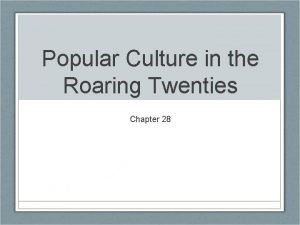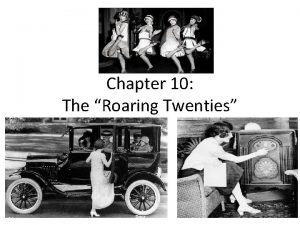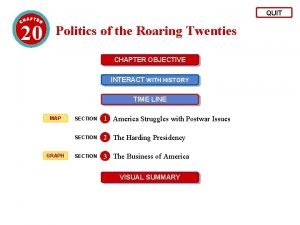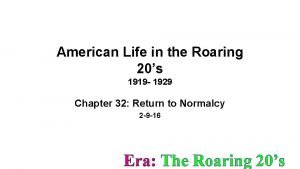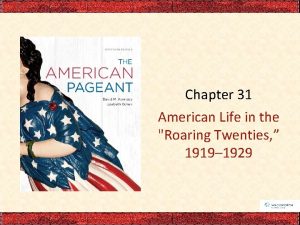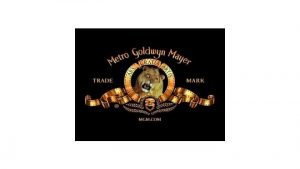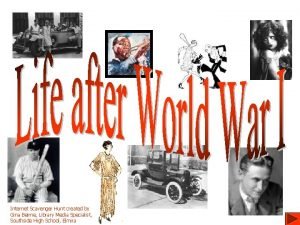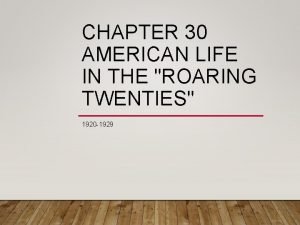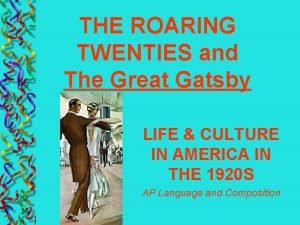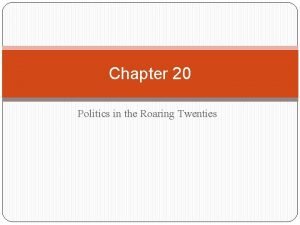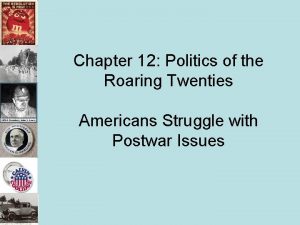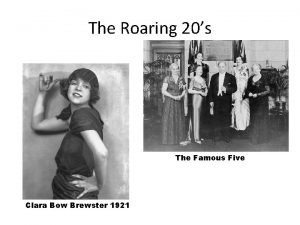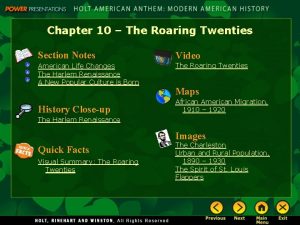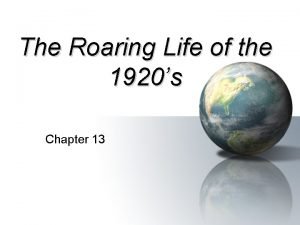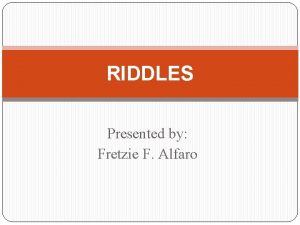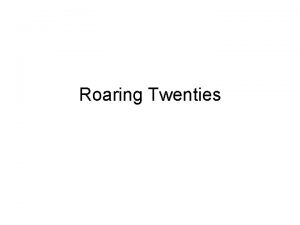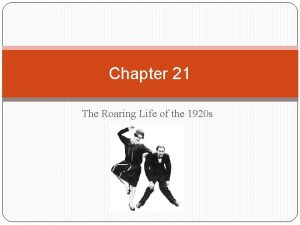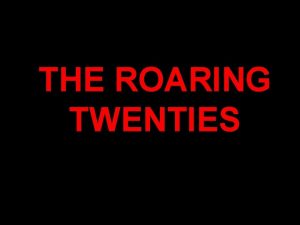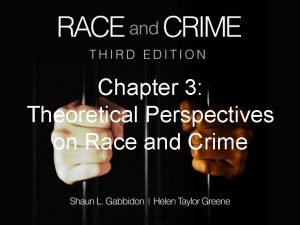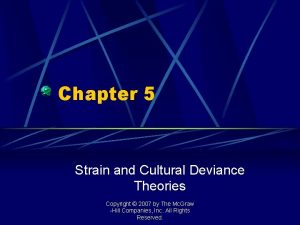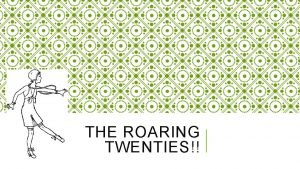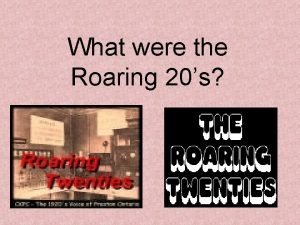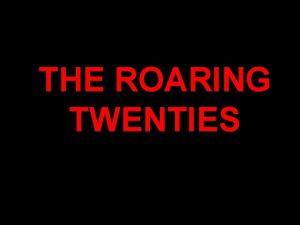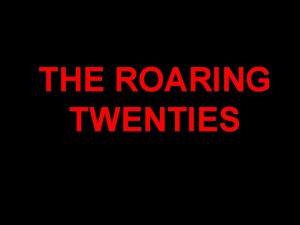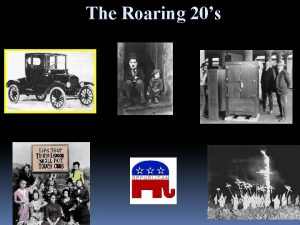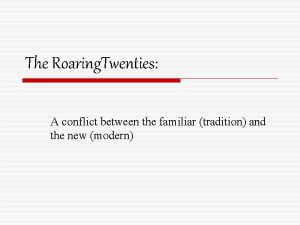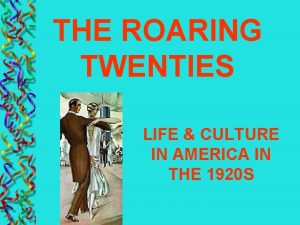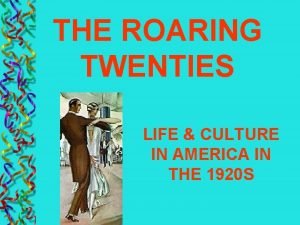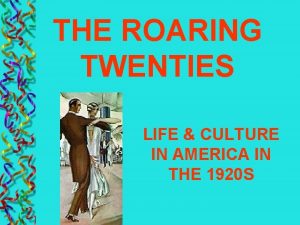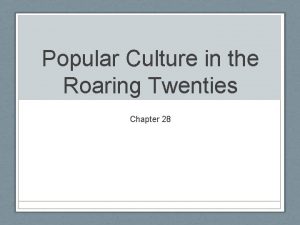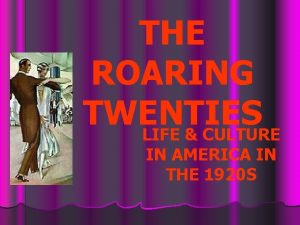The Roaring Twenties A Culture in Conflict The





















































- Slides: 53

The “Roaring Twenties”: A Culture in Conflict The 1920’s was a decade of transition characterized by rural backlash against the material, superficial values of an increasingly urban culture.

PRELUDE ©DEMOBILIZATION ©RECESSION ©STRIKES ©PALMER RAIDS, RED SCARE ©TERRORIST BOMBS ©RACE RIOTS; KKK

Cont’d ©The flu epidemic ©Wilson’s stroke ©the election of 1920

HARDING ADMIN. ©“NORMALCY” ©CONSERVATIVE ©SCANDALS ©TEAPOT DOME, ET AL ©COOLIDGE ©“The business of America is business. ”

POLICIES ©TARIFFS ©TAXES ©TRICKLE-DOWN ©FARM AID ©LABOR ©ERA

1920 s CULTURE ©HARLEM RENAISSANCE ©MARCUS GARVEY ©THE LOST GENERATION ©FLAPPERS ©CELEBRITIES DUKE ELLINGTON

CELEBRITIES ©GERTRUDE EDERLE ©JOHNNY WEISMULLER ©BOBBY JONES ©GENE TUNNEY, JACK DEMPSEY ©CHARLES LINDBERGH ©KNUTE ROCKNE

FADS OF THE 20 s ©crossword puzzles ©dance marathons ©mahjong ©flagpole sitting ©misc. ALVIN “SHIPWRECK” KELLY

MISCELLANEOUS * SACCO & VANZETTI * SCOPES TRIAL * AUTOMOBILE * RADIO * BULL MARKET

THE GREAT EXPERIMENT ©THE VOLSTEAD ACT ©THE TEMPERANCE MOVEMENT ©LEGISLATING MORALITY

PROHIBITION MYTHS ©ALCOHOL CONSUMPTION ©BEFORE AND AFTER ©RATIFICATION (18 TH) ©CRIME ©OTHER EFFECTS ©REPEAL (21 ST)

I. The Impact of World War I © Increased power of the Federal Government © Partnership forged between business and government © The “Great Migration” of southern Blacks © Temporary gains for women economically and socially © Short-lived economic recession in 1921

II. The “Red Scare” © Bolsheviks called for worldwide revolution in 1917 © Mail bombs in 1919 © Attorney-General A. Mitchell Palmer © Origins of the Scare © J. Edgar Hoover begins career hunting down radicals © Creation of the US Communist Party (1919)

II. The Red “Scare” (cont. ) © November raids on alien “radicals” --The “Soviet Ark” © More raids in January of 1920 © “May Day” hysteria fizzles © Legacy = crusade for 100% Americanism © Sacco and Vanzetti Case

III. A Culture “on the Grow” and “on the Move” © Increase of white collar workers © “Consumer goods revolution” © The automobile: symbol of the second American industrial revolution --Ford Motor Company founded in 1903 © The new technology of the moving assembly line

III. Culture “on the Move” (cont. ) © Social protest against the new technology © “Multiplier effect” of the auto industry © “Democratizing” the automobile © Impact of cars on residential housing patterns © The reality of traffic fatalities © The need for advertising

IV. Counter-Attacks from a More Traditional, Rural Culture

A. Prohibition © Reasons for victory of prohibition advocates © Volstead Act (1922) © Upper classes flaunted the law © A Boost to Organized Crime --Al “Scarface” Capone --St. Valentine’s Day Massacre (1929) © Ultimate failure of prohibition

B. Rebirth of the Ku Klux Klan © Reorganization of the Klan (1915) © Advertising techniques of the “consumer revolution” © Expanded “hate” list © Centered in the midwest © Especially strong among southern Democrats © The trial of Grand Dragon D. C. Stephenson

C. Religious Fundamentalism © Definition of “fundamentalism” © The Fundamentals (1910) © ACLU attack on prohibition against teaching on evolution © Scopes “Monkey” Trial —Dayton, TN (1925) © Economic implications of the Scopes Trial

C. Religious Fundamentalism (cont. ) © Carnival-like atmosphere around the Trial © Clarence Darrow vs. William Jennings Bryan © Bryan’s opposition to theory of evolution © Darrow cross-examined Bryan © Results of the Trial © Publicity of the Trial hurt fundamentalism

D. Immigration Restriction © 1917 Literacy Test © National Origins Quota Act (1924) © Slanted toward favoring “old immigrants” © Doors wide open to western hemisphere countries © Increased mechanization had reduced need for labor

V. The Politics of the 1920’s © Nation weary of reform and idealism © A return to “normalcy” © Progressivism transformed in a dark way © A Republican decade © Low voter turnout

A. The Presidency of Warren G. Harding (1921 -1923) © Compromise choice at stalled Republican convention in 1920 © Cox/FDR vs. Harding/Coolidge in 1920 campaign © Positive aspects of Harding’s presidency © Poor judge of character © Scandal-ridden administration

A. Harding’s Presidency (cont. ) © Teapot Dome Scandal © Secretary of the Treasury Andrew Mellon’s favoritism of the rich © High Tariffs plus insistence on repayment of European loans © Harding’s “Ohio gang” © Harding’s oratorical clumsiness

A. Harding’s Presidency (cont. ) © Harding was plagued with self-doubt © Wants to please everyone © Worked to dismantle progressive reform © Death of Harding (August, 1923) © Public response to Harding’s death and the decline of his reputation

B. The Presidency of Calvin Coolidge (1923 -1929) © Coolidge’s passive approach to the presidency © Famous for saying very little: “Silent Cal” © Built his presidency around conservative business values © Demonstrated hostility toward labor unions © The Election of 1924

B. Coolidge’s Presidency (cont. ) © Coolidge believed in little government intervention in the economy © Farmers became more business-like in their approach to farming

C. The Presidency of Herbert Hoover (1929 -1933) © Hoover’s background © Coolidge’s Secretary of Commerce © Hoover vs. Al Smith in the 1928 election © Very able administrator

C. Hoover’s Presidency (cont. ) © Hoover was more progressive and humanitarian than Coolidge © Hawley-Smoot Tariff of 1930 © Elected during a great time of prosperity, his fortunes will rise and fall with the economy

VI. The Culture of the Twenties: A Glittering Surface © A “mass” culture © Faith in the economy and American business © The notion of being very “modern” and “new” © Post-war disillusionment with the idea of the progress of civilization --Farewell to Arms (1929) --Waste Land (1922)

A. Radio and the Movies © First radio station = KDKA (Pittsburgh)— 1920 © NBC = first radio network (1926) © Average annual movie attendance = 90 million © The advent of “talkies” (1927) © Disney pioneers in the arena of animation and sound (1928)

B. Sports and Fads © The “Black Sox” scandal (1919) © Babe Ruth and Ty Cobb © The Significance of the Negro Leagues © College Football and Boxing © Beauty Pageants and Crossword puzzles --1 st Miss America (1921)

C. Literature and Education © Modernist literature explored the irrational and subconscious © F. Scott Fitzgerald --The Great Gatsby (1925) © Ernest Hemingway © Sinclair Lewis --Babbitt (1922) --Main Street (1920) © Enrollments and attendance up in all levels of education

D. The Importance of Science © New findings in physics shook the faith in human reason © The significance of Albert Einstein’s theories © Limits of Human Knowledge established --Heisenberg’s “Principle of Uncertainty” (1927) © Planck’s quantum theory

D. The Importance of Science © General cultural acceptance of the denial of absolute values © Robert Goddard launched the first liquid rocket (1926) © The Kelly Act (1925) © Lindbergh flies the Atlantic solo in May of 1927 © Growth of the airline industry

E. “The Sexual Revolution”, Divorce and the “New Woman” © Apparent loosening of American sexual mores © Sex seen as fun and discussed with frankness © Sexual content in magazines, movies and songs © Jazz as the musical complement to the era © The sexual revolution in literature

E. “The Sexual Revolution” (cont. ) © F. Scott Fitzgerald’s This Side of Paradise (1920) © The “flapper” stereotype © Sexual revolution more of a sideshow for most American women © Triumph of romantic love © Changing feminist goals © Escalating American divorce rate

F. The “Harlem Renaissance” and the “New Negro” © The Harlem Renaissance --Langston Hughes © “Negro Nationalism” of Marcus Garvey © Failure of an Anti. Lynching bill in Congress © Key Black Political victories © Legal strategy takes shape

G. Business and Skyscrapers © Americans worshipped material prosperity as they bought in installments © Chain stores begin to dominate the market © This decade was the age of the “manager” © The boom in advertising --Bruce Barton’s The Man Nobody Knows (1925)

G. Business and Skyscrapers (cont. ) © Critics of growing American materialism © Skyscrapers as the symbol of the veneration of corporate America © Skeletal structure of the skyscraper © The Woolworth Building (1913) © Period revivalism of these corporate symbols

G. Business and Skyscrapers (cont. ) © The race to build higher © The Chrysler Building (1929 -1930) © The Empire State Building (1931) © Skyscrapers offered new opportunities for women professionally

G. Business and Skyscrapers (cont. ) © Era of the richly decorated skyscrapers ended in the early 1930’s © New, unornamented modern skyscraper -- “Form follows function” © Business and prosperity very prominent on the cultural and political landscape in 1929

VII. The Culture of the Twenties: A Rotten Core © Problems for farmers during the 1920’s © Worker’s wages remained low --Tug River Mine War (1920 -1921) © Serious misdistribution of American wealth © Dangerous personal debt

Leaders of the 1920 s

The Roaring Twenties The decade of the twenties is often referred to as the “ Jazz Age’. However, the term has much to do with the jazzy atmosphere of the time as with the music!

Jazzy Sounds © Prohibition caused many of the jazz musicians to migrate north from New Orleans to Chicago © Joe “King” Oliver” was one of the best © His claim to fame was hiring Louis “Satchmo” Armstrong

Louis Armstrong © Louis Armstrong is the greatest single figure in the entire history of jazz. © The “Hot Five” seen here was one of the hottest groups of the twenties.

Jelly Roll Morton © Jelly Roll Morton led one of Chicago’s most popular groups © He was a piano player, band leader, and show business personality © He got the name “Jelly Roll” because he rolled his fingers and his music was sweet

Symphonic Jazz © George Gershwin wrote both classical and popular music © He was the first composer to combine jazz and classical music with Rhapsody in Blue in 1924. © He followed with © An American in Paris in 1928.

Jazzy Duds © Flappers were typical young girls of the twenties, usually with bobbed hair, short skirts, rolled stockings, and powdered knees! © They danced the night away doing the Charleston and the Black Bottom.

Jazzy Talk -Twenties Slang © All Wet - wrong © Berries - anything wonderful © Bee’s Knees - a superb person or thing © Big Cheese -an important person © Bump Off - to murder © Dumb Dora - a stupid girl © Flat Tire - a dull, boring person © Gam - a girls leg © Gin Mill - A speak easy © Hooch - bootleg liquor © Hoofer - chorus girl © Torpedo - a hired gunman

Twenty - Two Skidoo
 Chapter 28 popular culture in the roaring twenties
Chapter 28 popular culture in the roaring twenties Chapter 10 the roaring twenties
Chapter 10 the roaring twenties Chapter 20 politics of the roaring twenties answer key
Chapter 20 politics of the roaring twenties answer key The roaring twenties lesson 3 changing ways of life
The roaring twenties lesson 3 changing ways of life Roaring twenties acrostic poem
Roaring twenties acrostic poem Chapter 31 american life in the roaring twenties
Chapter 31 american life in the roaring twenties The roaring twenties canada
The roaring twenties canada Roaring twenties scavenger hunt answers
Roaring twenties scavenger hunt answers Chapter 30 american life in the roaring twenties
Chapter 30 american life in the roaring twenties The roaring 1920s were characterized by
The roaring 1920s were characterized by Roaring twenties great gatsby
Roaring twenties great gatsby Chapter 20 politics of the roaring twenties
Chapter 20 politics of the roaring twenties Politics of the roaring twenties chapter 12
Politics of the roaring twenties chapter 12 Roaring twenties acrostic poem
Roaring twenties acrostic poem Chapter 20 politics of the roaring twenties
Chapter 20 politics of the roaring twenties Chapter 10 the roaring twenties answer key
Chapter 10 the roaring twenties answer key Chapter 13 the roaring life of the 1920s
Chapter 13 the roaring life of the 1920s Roaring flame bunsen burner
Roaring flame bunsen burner O bid me leap, rather than marry paris meaning
O bid me leap, rather than marry paris meaning Tanan nakun
Tanan nakun Personification figure of speech examples
Personification figure of speech examples Demobilization and adjustment to peace 1920
Demobilization and adjustment to peace 1920 The roaring 20’s / jazz age
The roaring 20’s / jazz age Chapter 13 the roaring life of the 1920s
Chapter 13 the roaring life of the 1920s Roaring 20s fashion
Roaring 20s fashion Roaring rockets powerpoint
Roaring rockets powerpoint Roaring 20s vocabulary
Roaring 20s vocabulary External and internal conflict definition
External and internal conflict definition Internal vs external conflict
Internal vs external conflict What is conflict and conflict resolution?
What is conflict and conflict resolution? Culture conflict theory
Culture conflict theory What is real culture
What is real culture Define cultural deviance theory
Define cultural deviance theory Anaerobic culture method
Anaerobic culture method Stab and stroke culture
Stab and stroke culture Fed-batch
Fed-batch Folk culture and popular culture venn diagram
Folk culture and popular culture venn diagram Material culture examples
Material culture examples Lawn culture
Lawn culture Homework due today
Homework due today Individualistic culture vs. collectivist culture
Individualistic culture vs. collectivist culture A sub-culture group
A sub-culture group Sociologists define a symbol as
Sociologists define a symbol as Quality culture vs traditional culture
Quality culture vs traditional culture Indian culture vs american culture
Indian culture vs american culture What is folk culture
What is folk culture Inert organizational culture
Inert organizational culture Batch culture vs continuous culture
Batch culture vs continuous culture Surface culture deep culture and esol
Surface culture deep culture and esol Stroke culture method
Stroke culture method Vẽ hình chiếu vuông góc của vật thể sau
Vẽ hình chiếu vuông góc của vật thể sau 101012 bằng
101012 bằng Tỉ lệ cơ thể trẻ em
Tỉ lệ cơ thể trẻ em Lời thề hippocrates
Lời thề hippocrates
